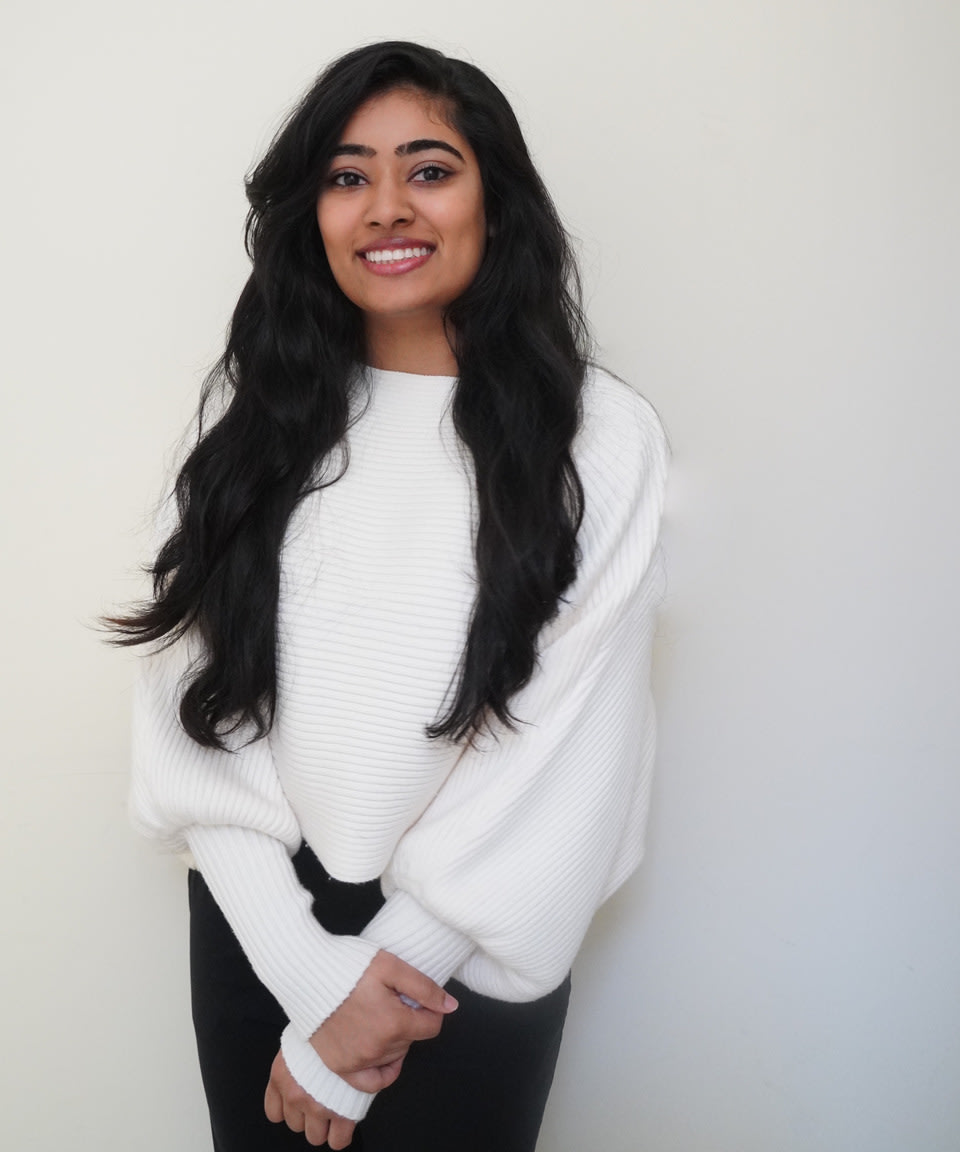I am a designer and developer focused on the future of human experiences. I use a nonintrusive design approach in multimodal interaction systems to push the boundaries of emerging and immersive technologies.
Experience:
I currently work as a designer for Long Distance, a performance fashion company in L.A. focused on wearable technology, wellness, and longevity.
Before my Master’s, I worked as a software application developer at Workday, a FinTech company in California, and as a freelancer in UX Design.
I recently helped design and produce the online exhibition, Museum of Design Atlanta, The Future Happened, and author an education initiative to empower teens in their creative expression.
Education:
MA/MSc Global Innovation Design, Royal College of Art & Imperial College London
University Scholars Program, Study Abroad, National University of Singapore
BSc Computer Information Systems, Barrett Honors College, Arizona State University
Minor in Digital Art | Minor in Fine Art | Certification in International Business
Guest Speaker:
Women’s Leadership Conference in Southern Oregon (2018)
Lesbians Who Tech & Allies (2018)
Grace Hopper Conference of Women in Computing (2017)


![[untitled]](https://res.cloudinary.com/rca2020/image/upload/f_auto,h_1080,w_1920,c_fill,g_auto,q_auto/v1/rca2021/60c557e3a98c7847e5484114-740808?_a=AXAH4S10)
![[untitled]](https://res.cloudinary.com/rca2020/image/upload/f_auto,h_1080,w_1920,c_fill,g_auto,q_auto/v1/rca2021/60c55806a98c7847e5486772-727428?_a=AXAH4S10)
![[untitled]](https://res.cloudinary.com/rca2020/image/upload/f_auto,h_1080,w_1920,c_fill,g_auto,q_auto/v1/rca2021/60c55806a98c7847e5486772-786682?_a=AXAH4S10)
![[untitled]](https://res.cloudinary.com/rca2020/image/upload/f_auto,h_1080,w_1920,c_fill,g_auto,q_auto/v1/rca2021/60c55806a98c7847e5486772-962734?_a=AXAH4S10)
![[untitled]](https://res.cloudinary.com/rca2020/image/upload/f_auto,h_1080,w_1920,c_fill,g_auto,q_auto/v1/rca2021/60c55829a98c7847e5487699-275396?_a=AXAH4S10)
![[untitled]](https://res.cloudinary.com/rca2020/image/upload/f_auto,h_1080,w_1920,c_fill,g_auto,q_auto/v1/rca2021/60c55829a98c7847e5487699-305564?_a=AXAH4S10)
![[untitled]](https://res.cloudinary.com/rca2020/image/upload/f_auto,h_1080,w_1920,c_fill,g_auto,q_auto/v1/rca2021/60c55829a98c7847e5487699-330309?_a=AXAH4S10)
![[untitled]](https://res.cloudinary.com/rca2020/image/upload/f_auto,h_1080,w_1920,c_fill,g_auto,q_auto/v1/rca2021/60c55829a98c7847e5487699-358266?_a=AXAH4S10)
![[untitled]](https://res.cloudinary.com/rca2020/image/upload/f_auto,h_1082,w_1920,c_fill,g_auto,q_auto/v1/rca2021/60c55829a98c7847e5487699-475475?_a=AXAH4S10)
![[untitled]](https://res.cloudinary.com/rca2020/image/upload/f_auto,h_1200,w_1920,c_fill,g_auto,q_auto/v1/rca2021/60c5584ea98c7847e54887fc-244233?_a=AXAH4S10)
![[untitled]](https://res.cloudinary.com/rca2020/image/upload/f_auto,h_1200,w_1920,c_fill,g_auto,q_auto/v1/rca2021/60c5584ea98c7847e54887fc-736220?_a=AXAH4S10)
![[untitled]](https://res.cloudinary.com/rca2020/image/upload/f_auto,h_1200,w_1920,c_fill,g_auto,q_auto/v1/rca2021/60c5584ea98c7847e54887fc-752567?_a=AXAH4S10)
![[untitled]](https://res.cloudinary.com/rca2020/image/upload/f_auto,h_1200,w_1920,c_fill,g_auto,q_auto/v1/rca2021/60c5584ea98c7847e54887fc-769973?_a=AXAH4S10)
![[untitled]](https://res.cloudinary.com/rca2020/image/upload/f_auto,h_1200,w_1920,c_fill,g_auto,q_auto/v1/rca2021/60c5584ea98c7847e54887fc-786825?_a=AXAH4S10)
![[untitled]](https://res.cloudinary.com/rca2020/image/upload/f_auto,h_1200,w_1920,c_fill,g_auto,q_auto/v1/rca2021/60c5584ea98c7847e54887fc-800176?_a=AXAH4S10)
![[untitled]](https://res.cloudinary.com/rca2020/image/upload/f_auto,h_1200,w_1920,c_fill,g_auto,q_auto/v1/rca2021/60c5584ea98c7847e54887fc-824346?_a=AXAH4S10)
![[untitled]](https://res.cloudinary.com/rca2020/image/upload/f_auto,h_1200,w_1920,c_fill,g_auto,q_auto/v1/rca2021/60c5584ea98c7847e54887fc-865584?_a=AXAH4S10)
![[untitled]](https://res.cloudinary.com/rca2020/image/upload/f_auto,h_1200,w_1920,c_fill,g_auto,q_auto/v1/rca2021/60c5584ea98c7847e54887fc-290280?_a=AXAH4S10)
![[untitled]](https://res.cloudinary.com/rca2020/image/upload/f_auto,h_1080,w_1920,c_fill,g_auto,q_auto/v1/rca2021/60c5585da98c7847e548b51f-108855?_a=AXAH4S10)
![[untitled]](https://res.cloudinary.com/rca2020/image/upload/f_auto,h_1080,w_1920,c_fill,g_auto,q_auto/v1/rca2021/60c5585da98c7847e548b51f-118887?_a=AXAH4S10)
![[untitled]](https://res.cloudinary.com/rca2020/image/upload/f_auto,h_1080,w_1920,c_fill,g_auto,q_auto/v1/rca2021/60c5585da98c7847e548b51f-129483?_a=AXAH4S10)
![[untitled]](https://res.cloudinary.com/rca2020/image/upload/f_auto,h_1081,w_1920,c_fill,g_auto,q_auto/v1/rca2021/60c5585da98c7847e548b51f-138621?_a=AXAH4S10)
![[untitled]](https://res.cloudinary.com/rca2020/image/upload/f_auto,h_1080,w_1920,c_fill,g_auto,q_auto/v1/rca2021/60c5585da98c7847e548b51f-150257?_a=AXAH4S10)